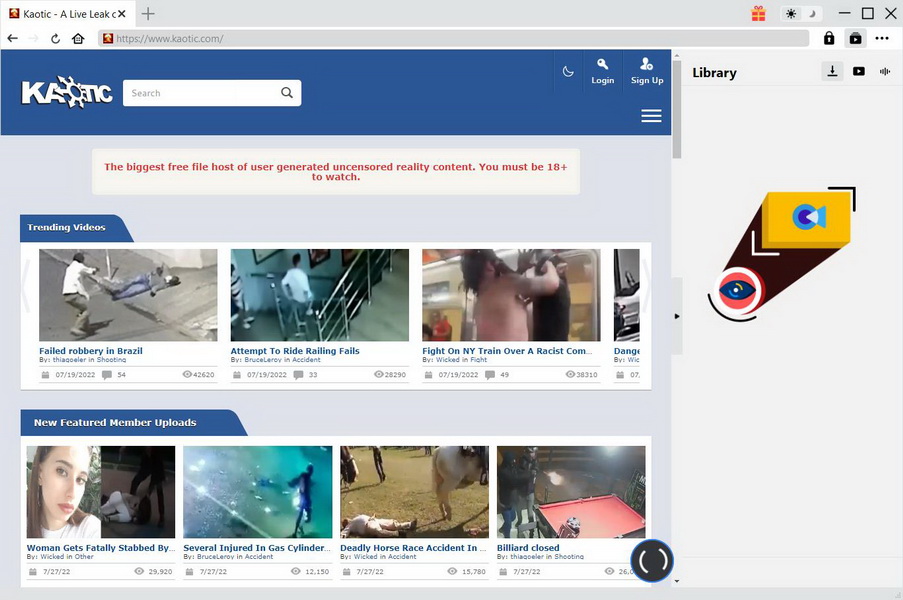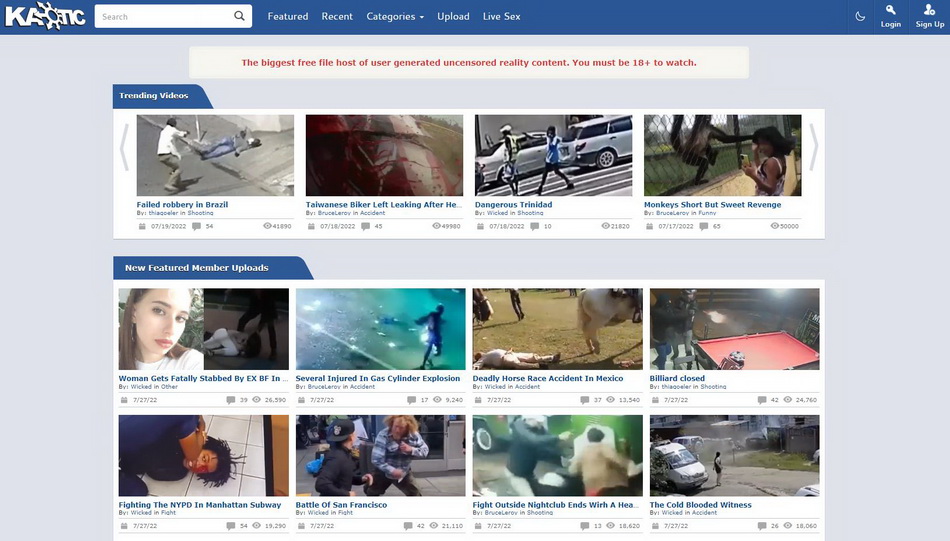Liveleak Alternatives: Where To Find Uncensored Content Now
Are you prepared to confront the unfiltered realities of the world, the kind that mainstream media shies away from? The internet, once a bastion for uncensored content, is witnessing a seismic shift as platforms known for their graphic and often disturbing content face increasing scrutiny and, in some cases, outright closure. This leaves a void for those seeking a raw, unvarnished view of reality, pushing them towards the darker corners of the web in search of alternatives.
The recent shuttering of Liveleak, a website synonymous with violent and gory footage, after fifteen years of operation, marks a significant turning point. Liveleak carved out a niche by hosting content that mainstream sites deemed too extreme, offering a platform for citizen journalism and unfiltered documentation of events around the globe. Its closure, announced by founder Hayden Hewitt, leaves a gaping hole in the online landscape for those seeking unedited and often disturbing content.
| Category | Information |
|---|---|
| Name | Hayden Hewitt |
| Occupation | Founder of Liveleak |
| Founded | Liveleak (2006) |
| Description | Known for hosting graphic and uncensored content that mainstream sites avoided. |
| Reason for Closure | Not publicly stated, but assumed to be multifaceted involving content moderation challenges and evolving online landscape. |
| Legacy | Pioneered a space for citizen journalism and unfiltered documentation of events, raising ethical questions about online content. |
| Reference | Wikipedia - Liveleak |
With Liveleak's demise, the question arises: where do those seeking such content now turn? Hewitt himself acknowledged this shift, implicitly pointing towards other platforms catering to this niche. This has inevitably led to a surge in traffic to sites operating on the fringes of the internet, places where the boundaries of acceptable content are pushed to their absolute limits.
One such alternative that has emerged in online discussions is Deep Gore Tube. Explicitly marketed as an 18+ site, Deep Gore Tube presents itself as a repository for videos and news that are deemed too extreme for mainstream platforms. The site openly advertises its uncensored and explicit content, promising viewers access to "the most bizarre videos" available online. The appeal lies in its promise of unfiltered reality, a collection of gore videos that allegedly explore the raw aspects of life and death without any sanitization or censorship.
The allure of these platforms is often rooted in a desire to witness the unvarnished truth, to see events as they unfold without the filters and narratives imposed by traditional media outlets. However, this quest for authenticity comes at a cost. The content found on these sites can be deeply disturbing, potentially causing psychological distress and desensitizing viewers to violence and suffering.
Kaotic, a platform highlighted through its official Twitter account (@officialkaotic), is another contender vying to fill the void left by Liveleak. Marketed as one of the biggest streaming sites for unique content, Kaotic boasts a vast library of gory videos available for free streaming. The site's search bar allows users to readily find specific content, and the platform prides itself on frequent updates, ensuring a constant stream of new and shocking material. The site's operators claim to share uncensored videos banned from YouTube and Facebook, further solidifying its image as a haven for content deemed too extreme for mainstream consumption.
- Baby Gronks Height How Tall Is He Really Facts Stats
- Kira Besha 19 Fabulous Exploring Tiktok Sensation
The rise of these platforms raises complex ethical questions. While proponents argue that they provide a necessary outlet for documenting reality and challenging censorship, critics contend that they contribute to the normalization of violence and the exploitation of human suffering. The line between documenting reality and exploiting tragedy is often blurred, leaving viewers to grapple with the moral implications of the content they consume.
Adding another layer to this complex landscape is the presence of communities like the "abruptchaos" subreddit, boasting a substantial 2.4 million subscribers. This community thrives on videos that capture moments of sudden and unexpected chaos, often presented in a humorous or darkly comedic light. While not explicitly focused on gore, the content found within this community can be unsettling, blurring the lines between entertainment and the documentation of real-life incidents.
The existence of "Vile Videos," a self-proclaimed "premier destination for those who dare to explore the darker, more disturbing side of visual content," further underscores the demand for extreme content. This platform offers a curated collection of videos designed to push boundaries, showcasing events and scenarios that are explicitly avoided by mainstream media. The appeal lies in the promise of experiencing something unique and shocking, a glimpse into the darker corners of human existence.
The roots of this online subculture can be traced back to early internet shock sites like Ogrish and Rotten.com. These platforms, popular in the early days of the web, served as destinations for those seeking to witness the most disturbing content imaginable. Liveleak itself emerged as an offshoot of Ogrish in 2006, further solidifying the connection between the desire for extreme content and the evolution of the internet landscape.
It's crucial to acknowledge that the consumption of such content can have a profound impact on individuals. Exposure to graphic violence and disturbing imagery can lead to desensitization, increased anxiety, and a distorted perception of reality. It's imperative that viewers approach these platforms with caution and be mindful of the potential psychological consequences.
The discussion surrounding Liveleak and its alternatives cannot be divorced from the broader debate about online censorship and freedom of speech. Proponents of uncensored content argue that it is essential for transparency and accountability, allowing the public to witness events as they truly unfold. Critics, however, contend that unrestricted access to violent and disturbing content can have detrimental effects on individuals and society as a whole.
The platforms that now exist in Liveleak's absence find themselves walking a tightrope. They must balance the desire to provide uncensored content with the need to protect their users from harmful material. This requires implementing robust content moderation policies, providing resources for those affected by the content, and engaging in ongoing dialogue about the ethical implications of their platforms.
The demand for uncensored content also reveals a broader societal fascination with death, violence, and the macabre. This fascination is often explored through various forms of entertainment, from horror movies to true crime documentaries. While these mediums offer a safe and controlled environment for exploring these themes, the content found on sites like Deep Gore Tube and Kaotic lacks such safeguards, presenting a raw and unfiltered view of reality that can be deeply unsettling.
Ultimately, the closure of Liveleak and the rise of its alternatives highlight the complex and evolving relationship between the internet, freedom of speech, and the consumption of disturbing content. As technology continues to advance and new platforms emerge, it is essential that we engage in ongoing dialogue about the ethical implications of online content and the responsibility of both creators and consumers. The quest for unfiltered reality should not come at the expense of human dignity and well-being.
The prevalence of sites featuring graphic content also indirectly highlights the continued presence of readily accessible pornography. The statement "Watch free hardcore sex in the comfort of your own office/home!" and the assertion that "Porn is the answer to all life's problems. Sex is good, sex is fun, sex is good for everyone!" represent the casual and often problematic attitude towards the accessibility and consumption of pornographic material. This contrasts sharply with the violence found elsewhere but speaks to the broader issue of online content regulation and its impact on societal norms.
The discussion also necessitates a look at content moderation strategies. Many of the aforementioned platforms, particularly those that host user-generated content, struggle with effectively moderating the material that is uploaded. The sheer volume of content, coupled with the speed at which it is disseminated, makes it difficult to identify and remove harmful or illegal material. This challenge is further compounded by the fact that content moderation is often outsourced to individuals who may lack the cultural context or training necessary to make informed decisions.
Furthermore, the algorithms that power these platforms can inadvertently amplify harmful content. Algorithms designed to maximize user engagement may prioritize sensational or controversial material, leading to a greater exposure to violent or disturbing imagery. This creates a feedback loop, where the demand for extreme content fuels the supply, and the algorithms further perpetuate the cycle.
It's crucial to consider the potential legal ramifications associated with hosting and consuming such content. Many countries have strict laws regarding the distribution of obscene material, and individuals who access or share such content could face criminal charges. Moreover, platforms that fail to adequately moderate their content could be held liable for the actions of their users, particularly in cases involving incitement to violence or the dissemination of illegal material.
The debate surrounding these platforms also touches upon the issue of desensitization. Repeated exposure to graphic violence can lead to a diminished emotional response, making it harder to empathize with victims and potentially contributing to a normalization of violence in real life. While research on the long-term effects of exposure to violent content is ongoing, there is growing concern about the potential impact on individuals and society as a whole.
Moreover, the consumption of such content can have a negative impact on mental health. Studies have shown a correlation between exposure to violent media and increased anxiety, depression, and post-traumatic stress disorder. Individuals who are already struggling with mental health issues may be particularly vulnerable to the harmful effects of such content.
The availability of these platforms also raises questions about parental responsibility. Parents need to be aware of the types of content their children are accessing online and take steps to protect them from harmful material. This may involve using parental control software, monitoring their children's online activity, and engaging in open and honest conversations about the dangers of the internet.
In conclusion, the closure of Liveleak and the rise of its alternatives represent a complex and evolving challenge for society. The desire for uncensored content must be balanced with the need to protect individuals from harm. This requires a multi-faceted approach involving robust content moderation policies, increased awareness of the potential psychological consequences, and ongoing dialogue about the ethical implications of online content. The future of the internet depends on our ability to navigate these challenges responsibly and ensure that the pursuit of truth does not come at the expense of human dignity and well-being.



Detail Author:
- Name : Dr. Archibald Hand DVM
- Username : haag.isidro
- Email : crist.christy@johnson.info
- Birthdate : 1975-04-27
- Address : 4723 Charley Mews Lake Russellville, WV 50092
- Phone : +1.938.771.7864
- Company : Rowe-Crona
- Job : Public Transportation Inspector
- Bio : Excepturi dicta adipisci eum totam nesciunt sed aspernatur. Qui quam debitis saepe officiis esse. Hic quos asperiores qui occaecati quod sit amet similique.
Socials
tiktok:
- url : https://tiktok.com/@alejandrinauer
- username : alejandrinauer
- bio : Ad temporibus beatae maxime et reprehenderit vel aliquam.
- followers : 4613
- following : 845
linkedin:
- url : https://linkedin.com/in/auera
- username : auera
- bio : Maxime adipisci dolorem quidem et ut non dicta.
- followers : 6113
- following : 23
twitter:
- url : https://twitter.com/alejandrin_auer
- username : alejandrin_auer
- bio : Consequuntur aut consequuntur velit hic soluta non est necessitatibus. Placeat consequatur dolor et. Et suscipit eligendi nisi iure qui.
- followers : 6625
- following : 329